Related Research Articles

The United States Army (USA) is the land service branch of the United States Armed Forces. It is one of the eight U.S. uniformed services, and is designated as the Army of the United States in the U.S. Constitution. The oldest and most senior branch of the U.S. military in order of precedence, the modern U.S. Army has its roots in the Continental Army, which was formed 14 June 1775 to fight the American Revolutionary War (1775–1783)—before the United States was established as a country. After the Revolutionary War, the Congress of the Confederation created the United States Army on 3 June 1784 to replace the disbanded Continental Army. The United States Army considers itself to be a continuation of the Continental Army, and thus considers its institutional inception to be the origin of that armed force in 1775.
The United States Armed Forces are the military forces of the United States. The armed forces consists of six service branches: the Army, Marine Corps, Navy, Air Force, Space Force, and Coast Guard. The president of the United States is the commander-in-chief of the armed forces and forms military policy with the Department of Defense (DoD) and Department of Homeland Security (DHS), both federal executive departments, acting as the principal organs by which military policy is carried out. All six armed services are among the eight uniformed services of the United States.

The Israel Defense Forces, alternatively referred to by the Hebrew-language acronym Tzahal (צה״ל), is the national military of the State of Israel. It consists of three service branches: the Israeli Ground Forces, the Israeli Air Force, and the Israeli Navy. It is the sole military wing of the Israeli security apparatus, and has no civilian jurisdiction within Israel. The IDF is headed by the Chief of the General Staff, who is subordinate to the Israeli Defense Minister.

The United States secretary of defense (SecDef) is the head of the United States Department of Defense, the executive department of the U.S. Armed Forces, and is a high ranking member of the federal cabinet. The secretary of defense's position of command and authority over the military is second only to that of the president of the United States, who is the commander-in-chief. This position corresponds to what is generally known as a defense minister in many other countries. The secretary of defense is appointed by the president with the advice and consent of the Senate, and is by custom a member of the Cabinet and by law a member of the National Security Council.

The Defense Meritorious Service Medal (DMSM) is an award bestowed upon members of the United States military by the United States Department of Defense. In the order of precedence of the United States Armed Forces, it is worn between the Purple Heart and the Meritorious Service Medal. The medal is awarded in the name of the Secretary of Defense to members of the Armed Forces who, while serving in a joint activity, distinguish themselves by non-combat outstanding achievement or meritorious service, but not of a degree to warrant award of the Defense Superior Service Medal.
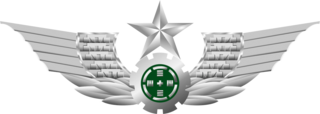
The People's Liberation Army Ground Force is the land-based service branch of the People's Liberation Army and the largest and oldest branch of the entire Chinese armed forces. The PLAGF can trace its lineage from 1927 as the Chinese Red Army; however, it was not officially established until 1948.
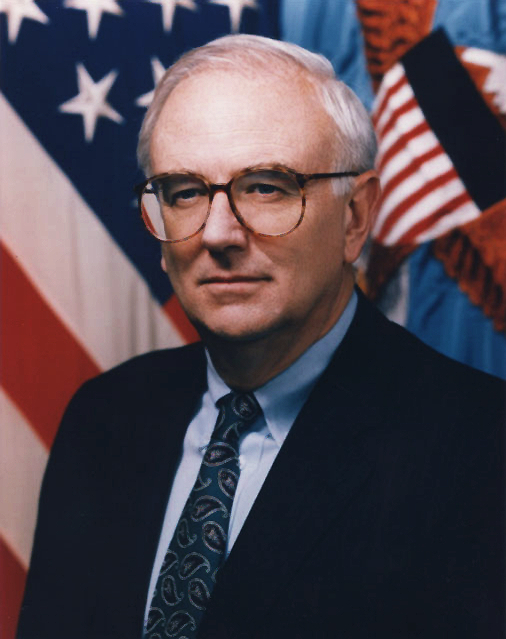
Leslie Aspin Jr. was an American Democratic Party politician who served as the U.S. representative for Wisconsin's 1st congressional district from 1971 to 1993 and as the 18th United States Secretary of Defense under President Bill Clinton from 1993 to 1994.

Rupert "Rudy" Frank de Leon Jr. is an American former senior Department of Defense official, military adviser, lobbyist, and foreign policy adviser. He served as the Deputy Secretary of Defense, described as the "second-highest civilian defense position", from March 31, 2000 until March 16, 2001, and before appointed as Deputy Secretary he had served as Under Secretary of Defense for Personnel and Readiness from 1997 until 2000 and as Under Secretary of the Air Force from 1994 to 1997 in the administration of Bill Clinton.

Women in combat refers to female military personnel assigned to combat positions. The role of women in the military has varied across the world’s major countries throughout history with several views for and against women in combat.

Many women have served in the United States Navy for over a century. As of 2020, there were 69,629 total women on active duty in the US Navy, with 11,076 serving as officers, and 58,553 enlisted. Of all the branches in the US military, the Navy has the second highest percentage of female active duty service members with women making up 20% of the US Navy in 2020.

The United States Army Air Forces was the major land-based aerial warfare service component of the United States Army and de facto aerial warfare service branch of the United States during and immediately after World War II (1941–1945). It was created on 20 June 1941 as successor to the previous United States Army Air Corps and is the direct predecessor of the United States Air Force, today one of the six armed forces of the United States. The AAF was a component of the United States Army, which on 2 March 1942 was divided functionally by executive order into three autonomous forces: the Army Ground Forces, the United States Army Services of Supply, and the Army Air Forces. Each of these forces had a commanding general who reported directly to the Army Chief of Staff.

Recent history of changes in women's roles includes having women in the military in many countries. Although most countries in the world permit the participation of women in the military, in one form or another, in 2018, only two countries conscripted women and men on the same formal conditions: Norway and Sweden. A few other countries have laws allowing for the conscription of women into their armed forces, however with some difference such as service exemptions, length of service, and more. Some countries do not have conscription, but men and women may serve on a voluntary basis under equal conditions.
The role of women in the United States armed services became an important political topic in 1991. Women military personnel had engaged in combat in the most recent U.S. military actions: Grenada in 1983 Panama in 1989, and the Gulf War in 1991. Senator William V. Roth (R-DE) introduced a Senate bill in 1991 to clarify women's roles in the armed forces, including combat.
Shane Ortega is a retired Army Staff Sergeant and Marine Corps veteran. Ortega was stationed at Wheeler Airfield in Oahu, Hawaii in the 3-25th Combat Aviation Division of the Army's 25th Infantry Division. He was a member of the Gay Men's Chorus of Honolulu and competed at the professional level of bodybuilding, placing fourth in fall 2015.
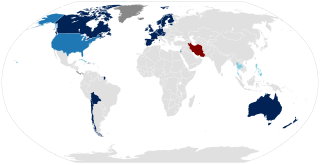
Not all armed forces have policies explicitly permitting LGBT personnel. Generally speaking, Western European militaries show a greater tendency toward inclusion of LGBT individuals. As of January 2021, 21 countries allow transgender military personnel to serve openly: Australia, Austria, Belgium, Bolivia, Brazil, Canada, Chile, Czechia, Denmark, Estonia, Finland, France, Germany, Ireland, Israel, the Netherlands, New Zealand, Norway, Spain, Sweden, and the United Kingdom. Cuba and Thailand reportedly allowed transgender service in a limited capacity. In 1974, the Netherlands was the first country to allow transgender military personnel. The United States has allowed transgender personnel to serve in the military under varying conditions since Joe Biden's signing of an executive order.

There have been women in the United States Army since the Revolutionary War, and women continue to serve in it today. As of 2020, there were 74,592 total women on active duty in the US Army, with 16,987 serving as officers and 57,605 enlisted. While the Army has the highest number of total active duty members, the ratio of women-men is lower than the US Air Force and the US Navy, with women making up 15.5% of total active duty Army in 2020.
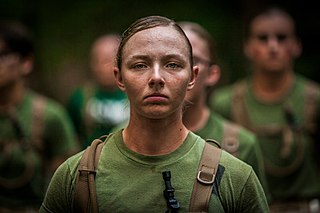
There have been women in the United States Marine Corps since 1918, and women continue to serve in the Corps today. As of 2020, women make up 8.9% of total active duty Marines. These numbers give the Marine Corps the lowest ratio of women in all of the U.S military branches. Women's presence in the Marine Corps first emerged in 1918 when they were permitted to do administrative work in an attempt to fill the spots of male Marines fighting overseas. It was not until 1948 that women were able to become a permanent part of the Corps with the passing of the Women's Armed Services Integration Act. However, even with the Integration Act, women were still banned from certain military occupation specialties. It was not until 2016 that Defense Secretary Ash Carter announced that all military occupations would be open to women without exception. As of 2018, there were 18 women serving in the Marine Corps combat arms. In December 2020, the Marine Corps Recruit Depot San Diego agreed to join the Marine Corps Recruit Depot Parris Island in accepting female recruits, with 60 female recruits starting their boot camp training at the San Diego depot in February 2021. 53 of these recruits would successfully graduate from boot camp in April 2021 and become Marines.

There have been women in the United States Air Force since 1948, and women continue to serve in it today.

Mary Jennings Hegar is an American United States Air Force veteran and former political candidate. In 2012, she sued the U.S. Air Force to remove the Combat Exclusion Policy. In 2017, she published the memoir Shoot Like a Girl, which describes her service in Afghanistan.
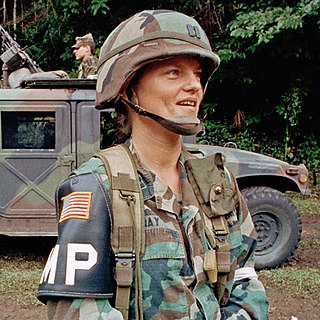
Linda L. Bray is a former U.S. Army officer known for being the first woman in the United States military to lead troops into combat. She served in the Panama Invasion and during the Cold War. Bray's career started in 1982 and ended with her retirement in 1991.
References
- ↑ Combat Exclusion: An Equal Protection Analysis, Captain Stephanie Stephens, DTIC
- ↑ Lohrenz, Carey D. (January 30, 2013). "Time for Some Fearless Leadership". Time . Retrieved September 18, 2018.
- ↑ "Department of Defense active duty military personnel by rank/grade". Department of Defense. Retrieved May 10, 2012.
- ↑ Army Regulation (March 27, 1992). "Army Regulation 600-13, Army Policy For The Assignment of Female Soldiers". Department of the Army.
- ↑ "Panel Says Rescind Policy on Women in Combat". Archived from the original on February 5, 2012. Retrieved February 6, 2012.
- ↑ "US military to ease curbs on women in combat roles". Bbc.co.uk. Retrieved September 18, 2018.
- ↑ Bumiller, Elisabeth (February 9, 2012). "Pentagon allows women closer to combat, but not close enough for some". The New York Times . Retrieved May 10, 2012.
- ↑ "Defense.gov News Article: Defense Department Expands Women's Combat Role". Archived from the original on April 12, 2014. Retrieved March 3, 2014.
- ↑ Amos, James F. "General". Commandant of the Marine Corps. United States Marine Corps. Retrieved January 25, 2013.
- ↑ Roulo, Claudette (January 24, 2013). "Defense Department Expands Women's Combat Role". American Forces Press Service. Retrieved March 3, 2014.
- ↑ Vanden Brook, Tom; Michaels, Jim (January 23, 2013). "Officials: Panetta opens combat roles to women". Army Times . Retrieved March 3, 2014.